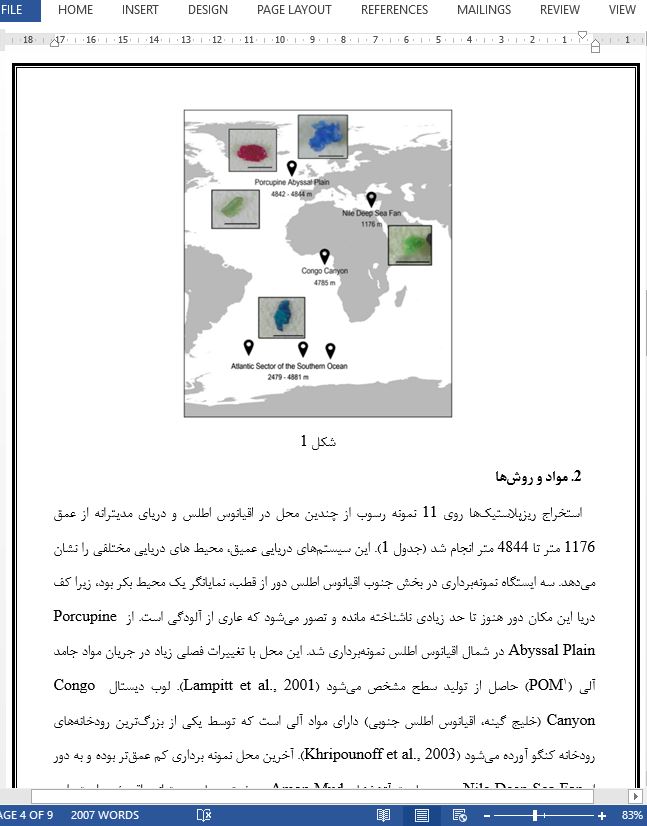| دانلود رایگان مقاله انگلیسی + خرید ترجمه فارسی | |
| عنوان فارسی مقاله: |
آلودگی ریزپلاستیک در رسوبات دریایی عمیق |
| عنوان انگلیسی مقاله: |
Microplastic pollution in deep-sea sediments |
|
|
|
| مشخصات مقاله انگلیسی (PDF) | |
| سال انتشار | 2013 |
| تعداد صفحات مقاله انگلیسی | 5 صفحه با فرمت pdf |
| رشته های مرتبط با این مقاله | محیط زیست |
| گرایش های مرتبط با این مقاله | آلودگی محیط زیست |
| چاپ شده در مجله (ژورنال) | آلودگی محیطی – Environmental Pollution |
| کلمات کلیدی | ریزپلاستیک ها، دریای عمیق، رسوبات، آلودگی |
| ارائه شده از دانشگاه | آزمایشگاه سم شناسی محیطی و اکولوژی آبی، دانشگاه گنت، بلژیک |
| نویسندگان | Lisbeth Van Cauwenberghe, Ann Vanreusel, Jan Mees, Colin R. Janssen |
| شناسه شاپا یا ISSN | ISSN 0269-7491 |
| شناسه دیجیتال – doi | https://doi.org/10.1016/j.envpol.2013.08.013 |
| رفرنس | دارد ✓ |
| کد محصول | 9560 |
| لینک مقاله در سایت مرجع | لینک این مقاله در نشریه Elsevier |
| نشریه الزویر |  |
| مشخصات و وضعیت ترجمه فارسی این مقاله (Word) | |
| وضعیت ترجمه | انجام شده و آماده دانلود |
| کیفیت ترجمه | طلایی⭐️ |
| تعداد صفحات ترجمه تایپ شده با فرمت ورد با قابلیت ویرایش | 9 صفحه با فونت 14 B Nazanin |
| ترجمه عناوین تصاویر و جداول | ترجمه نشده است ☓ |
| ترجمه متون داخل تصاویر | ترجمه نشده است ☓ |
| ترجمه متون داخل جداول | ترجمه نشده است ☓ |
| درج تصاویر در فایل ترجمه | درج شده است ✓ |
| درج جداول در فایل ترجمه | درج شده است ✓ |
| منابع داخل متن | به صورت انگلیسی درج شده است ✓ |
| فهرست مطالب |
|
چکیده 1- مقدمه 2- مواد و روش ها 3- نتایج و بحث |
| بخشی از ترجمه |
|
چکیده ریزپلاستیک ها، ذرات پلاستیکی کوچک (کمتر از 1 میلی متر) ناشی از تخریب بقایای پلاستیکی بزرگتر هستند. این ریزپلاستیک ها در دهه های مختلف در محیط دریایی تجمع یافته و در سراسر ستون آب و رسوبات زیرین و ساحلی در سراسر جهان شناسایی شده اند. تا کنون مشخص نشده است که آیا حضور ریزپلاستیک ها در رسوبات محدود به نقاط داغ تجمع آن ها مانند فلات قاره ای است یا اینکه آیا ریزپلاستیک ها در رسوبات عمیق دریا وجود دارند. در اینجا برای اولین بار نشان داده می شود که این ریزپلاستیک ها به دورترین محیط های دریایی: دریای عمیق رسیده اند. ذرات پلاستیکی با اندازه ی میکرومتر در رسوبات دریایی عمیق در چهار مکان نشان دهنده زیستگاه های مختلف عمیق دریایی در محدوده ی عمق 1100 تا 5000 متر جمع آوری شده است. نتایج نشان می دهد که آلودگی ریزپلاستیک در سراسر دریاها و اقیانوس ها، در دریاهای عمیق دور و ناشناخته گسترش یافته است.
3- نتایج و بحث |
| بخشی از مقاله انگلیسی |
|
Abstract Microplastics are small plastic particles (<1 mm) originating from the degradation of larger plastic debris. These microplastics have been accumulating in the marine environment for decades and have been detected throughout the water column and in sublittoral and beach sediments worldwide. However, up to now, it has never been established whether microplastic presence in sediments is limited to accumulation hot spots such as the continental shelf, or whether they are also present in deep-sea sediments. Here we show, for the first time ever, that microplastics have indeed reached the most remote of marine environments: the deep sea. We found plastic particles sized in the micrometre range in deep-sea sediments collected at four locations representing different deep-sea habitats ranging in depth from 1100 to 5000 m. Our results demonstrate that microplastic pollution has spread throughout the world’s seas and oceans, into the remote and largely unknown deep sea.
3- Results & discussion In three of the four locations studied, microplastics were recovered from the top 1 cm of the sediment samples (see Fig. 1). In total, five particles were identified as possible microplastics: 1 particle originating from the Nile Deep Sea Fan, 1 from the Southern ocean, and three particles from the Porcupine Abyssal Plain. No particles were recovered from the Congo Canyon. Based on the (limited) surface sampled it can tentatively be concluded that in/on the sea floor of the deep sea, microplastics can reach an average abundance of 0.5 microplastics per 25 cm2 (N ¼ 11) in the top centimetre of sediment. The highest concentration of microplastics was encountered in the sediment of the Porcupine Abyssal Plain: here, microplastics reached an average concentration of 1 particle per 25 cm2 (N ¼ 3). It is remarkable that no or limited numbers of microplastics were recovered from the location off the Congo and Nile rivers, since these rivers pass through countries that lack adequate waste management. Because of the small sample sizes (only two to three cores per location) and the small volumes per core, the fact that no microplastics were encountered does not imply that no microplastics were present at all. In addition, due to the high organic content of the samples originating from the Congo Canyon the filters contained high amounts of organic (plant) material that impeded the visual inspection for microplastics. It is thus possible that microplastics present in these samples were missed. The sampling stations in the Mediterranean are located near the edge of the Nile Delta Fan, where we would expect a reduced riverine input.
|
|
تصویری از مقاله ترجمه و تایپ شده در نرم افزار ورد |
|
|
| دانلود رایگان مقاله انگلیسی + خرید ترجمه فارسی | |
| عنوان فارسی مقاله: |
آلودگی ریزپلاستیک در رسوبات دریایی عمیق |
| عنوان انگلیسی مقاله: |
Microplastic pollution in deep-sea sediments |
|
|
|
